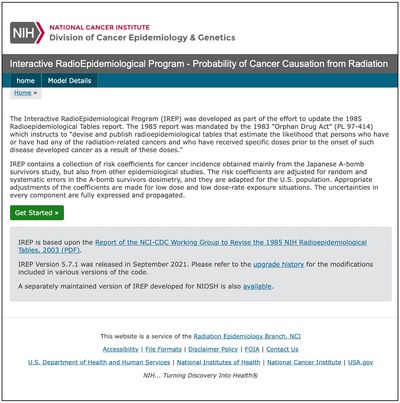Probability of Causation for Radiogenic CanceR
Oak Ridge Center for Risk Analysis (ORRISK) collaborated with the Radiation Epidemiology Branch of the National Cancer Institute (NCI) and the Radiation Studies Branch of the Centers for Disease Control and Prevention (CDC) to revise the 1985 NIH Radioepidemiological Tables. The 1985 Report of the NIH Ad Hoc Working Group to Develop Radioepidemiological Tables, which was mandated by Congress, provides a scientific basis for adjudicating claims of radiation-related cancer incidence, and is now legally mandated for use in claims against the government or its contractors associated with occupational exposure. This is an updated report, using more recent epidemiological dose-response data and a formal quantitative uncertainty analysis incorporating statistical and subjective assessments of uncertainty. The original tabular format was replaced by an interactive computer program that is accessible from the National Cancer Institute web site: https://www.irep.nci.nih.gov/irep
The published report is available on the NCI website at: http://dceg.cancer.gov/files/NIH_No_03-5387.pdf (Land CE, Gilbert E, Smith J, Hoffman FO, Apostoaei I, Thomas B, Kocher D. Report of the NCI-CDC Working Group to revise the 1985 NIH Radioepidemiological Tables. NIH Publication No. 03-5387. 2003.)
The Report of the NCI-CDC Working Group to Revise the 1985 NIH Radioepidemiological Tables (2003) updates the former report in significant ways. It provides:
- New availability of risk data at the level of incidence.
- New attention to cancer sites less strongly associated with radiation exposure
- New analytical approaches and ways of summarizing data
- More attention to uncertainty and presentation of risk
- Use of organ-specific equivalent dose, in sievert (Sv)
- Interactive computer programs as an alternative to tabular presentation, to estimate the “assigned share,” or probability of causation that a given cancer is related to past exposure
The tabular presentation of the 1985 report allowed users to look up tabulated coefficients appropriate to particular claims, and to calculate assigned share using these coefficients according to simple algorithms presented in the report. Increased computing power has made it possible to calculate assigned share and its uncertainty directly, for individual claims, from the particulars of exposure history, disease, and other relevant factors. This results in quicker, easier, and less error-prone computation, with tabular and/or graphical output options.
Oak Ridge Center for Risk Analysis worked with the National Cancer Institute (NCI) staff to evaluate statistical and subjective uncertainties attached to each of the various components of the estimated radiation-related excess relative risk of being diagnosed with particular cancers at specific ages for otherwise typical members of the U.S. population. These components included organ-specific radiation doses, age at exposure, sex, estimated organ-specific risk coefficients and their transfer to a U.S. population, exposure to other carcinogens, and other factors specified by NCI staff thought to influence radiation-related risk. Working with NCI staff, Oak Ridge Center for Risk Analysis evaluated the combined effect of the individual uncertainties on the estimated probability of causation in particular cases. The end product was a user-friendly interactive computer program for computing an uncertainty distribution for probability of causation of cancer given specified information about the individual cancer, including type of cancer, age and date of diagnosis, sex, history of radiation exposure of direct interest (e.g., occupational exposure), and of indirect interest (e.g., therapeutic radiation or treatment of an earlier cancer), and other risk factors such as smoking history and reproductive history.
NIOSH-IREP Used in Support of DOE Compensation Claims
The current version of the NIOSH version of IREP is available via the Internet as an interactive web-based code with a user-friendly interface on the NIOSH Office of Compensation Analysis and Support website: https://www.cdc.gov/niosh/ocas/nioshirep.html
Oak Ridge Center for Risk Analysis is providing support to the National Institute for Occupational Safety and Health (NIOSH) in implementing the provisions of the Energy Employees Occupational Illness Compensation Program Act of 2000 (EEOICPA). This Act requires the establishment of guidelines for determining eligibility for compensation of individuals who were exposed to radiation in the performance of duty for nuclear weapons production programs of the Department of Energy and its predecessor agencies. For individuals other than members of special exposure cohorts, compensation will be awarded to those for whom it is “more likely than not” that their cancers were induced by their occupational exposure to radiation.
The decision for compensation is based on a reconstruction of the organ doses received by each person and a calculation of the probability of causation (PC), defined as the risk of the given cancer attributable to radiation exposure divided by the total risk for that cancer. To estimate the PC, Oak Ridge Center for Risk Analysis is providing NIOSH with the most recent update of the National Institutes of Health’s 1985 Radioepidemiological Tables implemented in the form of the Interactive RadioEpidemiological Program (IREP).
IREP is a computer code capable of estimating the PC for nearly every cancer type, based on organ doses from each kind of radiation and exposure rate, and accounting for gender, age at exposure, age at diagnosis, and other risk factors such as smoking history. For most cancers, the initial values of the risk coefficients used to estimate a PC are based on epidemiological investigations of cancer incidence in the cohort of Japanese who survived the atomic bombings of Hiroshima and Nagasaki. A series of modifications and adjustments are made to enable extrapolation of risk estimates to members of the U.S. population who were exposed in an occupational setting. In IREP, all uncertain model inputs and assumptions are specified as probability distributions, and a full analysis of uncertainty in the estimated PC is performed using Monte Carlo simulations.
Information about NIOSH - IREP used in support of DOE compensation claims

